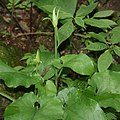Ainu cuisine
An overview of the traditional cuisine of the Ainu people of Japan
Ainu cuisine refers to the traditional food practices and dishes of the Ainu people, the indigenous inhabitants of Hokkaido, Sakhalin, and the Kuril Islands. Ainu cuisine is distinct from the more widely known Japanese cuisine and reflects the Ainu's close relationship with nature and their reliance on the natural resources available in their environment.
Ingredients and Food Sources[edit]
Ainu cuisine is characterized by its use of natural ingredients sourced from the surrounding environment. The Ainu traditionally relied on hunting, fishing, and gathering to obtain their food.
Meat and Fish[edit]

The Ainu diet includes a variety of meats and fish. Salmon is particularly important and is often prepared in various ways, such as drying or smoking. Other fish commonly consumed include trout and herring. The Ainu also hunt animals such as deer, bear, and rabbit, which are used in stews and other dishes.
Plants and Vegetables[edit]
The Ainu gather a wide range of wild plants and vegetables. These include fuki (butterbur), udo (Aralia cordata), and various types of wild greens. These plants are often boiled or used in soups and stews.
Grains and Nuts[edit]
While the Ainu did not traditionally cultivate rice, they did use grains such as millet and barley. Nuts, such as walnuts and acorns, are also part of the Ainu diet and are often ground into flour or used as a thickening agent in soups.
Traditional Dishes[edit]
Ainu cuisine includes a variety of traditional dishes that reflect their unique culinary practices.
Ohaw[edit]
Ohaw is a traditional Ainu soup made with fish or meat and a variety of vegetables. It is seasoned with salt and sometimes flavored with miso or soy sauce.
Sito[edit]
Sito are dumplings made from millet or other grains. They are often served in soups or stews.
Chitatap[edit]
Chitatap is a dish made by finely chopping meat or fish with a knife. It is often mixed with wild vegetables and seasoned with salt.
Cultural Significance[edit]
Ainu cuisine is not only about sustenance but also holds cultural and spiritual significance. Many Ainu dishes are prepared and consumed during traditional ceremonies and festivals. The preparation and sharing of food are integral to Ainu social and cultural life.
Modern Influence and Preservation[edit]
Today, there is a growing interest in preserving and revitalizing Ainu culture, including its culinary traditions. Efforts are being made to document traditional recipes and promote Ainu cuisine to a wider audience. Some restaurants in Hokkaido now offer Ainu dishes, allowing both locals and tourists to experience this unique culinary heritage.
Gallery[edit]
-
Ainu cuisine
-
Ainu cuisine
-
Ainu cuisine
-
Ainu cuisine
-
Ainu cuisine
-
Ainu cuisine
-
Ainu cuisine
-
Ainu cuisine
-
Ainu cuisine
-
Ainu cuisine
-
Ainu cuisine
Related pages[edit]
Ad. Transform your life with W8MD's Budget GLP-1 injections from $75


W8MD offers a medical weight loss program to lose weight in Philadelphia. Our physician-supervised medical weight loss provides:
- Weight loss injections in NYC (generic and brand names):
- Zepbound / Mounjaro, Wegovy / Ozempic, Saxenda
- Most insurances accepted or discounted self-pay rates. We will obtain insurance prior authorizations if needed.
- Generic GLP1 weight loss injections from $75 for the starting dose.
- Also offer prescription weight loss medications including Phentermine, Qsymia, Diethylpropion, Contrave etc.
NYC weight loss doctor appointmentsNYC weight loss doctor appointments
Start your NYC weight loss journey today at our NYC medical weight loss and Philadelphia medical weight loss clinics.
- Call 718-946-5500 to lose weight in NYC or for medical weight loss in Philadelphia 215-676-2334.
- Tags:NYC medical weight loss, Philadelphia lose weight Zepbound NYC, Budget GLP1 weight loss injections, Wegovy Philadelphia, Wegovy NYC, Philadelphia medical weight loss, Brookly weight loss and Wegovy NYC
|
WikiMD's Wellness Encyclopedia |
| Let Food Be Thy Medicine Medicine Thy Food - Hippocrates |
Medical Disclaimer: WikiMD is not a substitute for professional medical advice. The information on WikiMD is provided as an information resource only, may be incorrect, outdated or misleading, and is not to be used or relied on for any diagnostic or treatment purposes. Please consult your health care provider before making any healthcare decisions or for guidance about a specific medical condition. WikiMD expressly disclaims responsibility, and shall have no liability, for any damages, loss, injury, or liability whatsoever suffered as a result of your reliance on the information contained in this site. By visiting this site you agree to the foregoing terms and conditions, which may from time to time be changed or supplemented by WikiMD. If you do not agree to the foregoing terms and conditions, you should not enter or use this site. See full disclaimer.
Credits:Most images are courtesy of Wikimedia commons, and templates, categories Wikipedia, licensed under CC BY SA or similar.
Translate this page: - East Asian
中文,
日本,
한국어,
South Asian
हिन्दी,
தமிழ்,
తెలుగు,
Urdu,
ಕನ್ನಡ,
Southeast Asian
Indonesian,
Vietnamese,
Thai,
မြန်မာဘာသာ,
বাংলা
European
español,
Deutsch,
français,
Greek,
português do Brasil,
polski,
română,
русский,
Nederlands,
norsk,
svenska,
suomi,
Italian
Middle Eastern & African
عربى,
Turkish,
Persian,
Hebrew,
Afrikaans,
isiZulu,
Kiswahili,
Other
Bulgarian,
Hungarian,
Czech,
Swedish,
മലയാളം,
मराठी,
ਪੰਜਾਬੀ,
ગુજરાતી,
Portuguese,
Ukrainian










